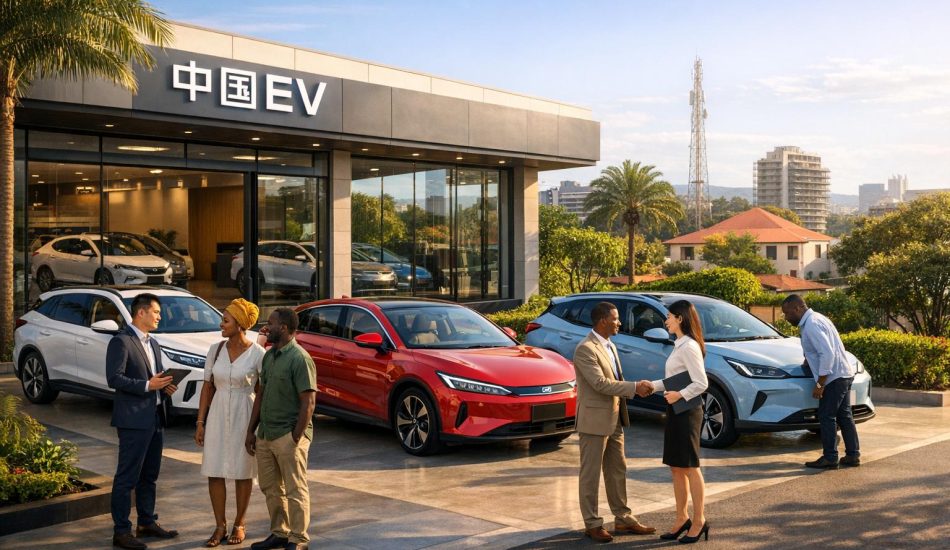
Switching to electric vehicles (EVs) can save your fleet money, reduce emissions, and improve performance. While EVs may have higher upfront costs, their long-term benefits make them a smart choice for fleet operators in Africa. Here’s why:
- Lower Operating Costs: EVs cost less to run over their lifetime compared to traditional vehicles. For example, ICE (internal combustion engine) fleets have 38% higher lifetime costs than electric ones. Solar charging can further reduce costs by up to 47%.
- Reduced Emissions: EVs help improve air quality by cutting harmful pollutants, especially in regions like Kenya, where 93% of electricity comes from renewable energy.
- Improved Performance: EVs require less maintenance due to fewer moving parts and deliver better reliability with instant torque.
Quick Overview of Africa’s EV Progress:
- Cape Verde: Plans to ban ICE vehicle imports by 2035.
- South Africa: Aims for 20% of light-duty vehicles to be hybrids by 2030.
- Rwanda: Targets 30% electrification of motorcycles by 2030, saving $22M on fuel imports annually.
EV success stories like Ampersand and BasiGo highlight the economic and environmental potential of electric mobility in Africa. Ready to make the switch? Start by evaluating your fleet, planning charging infrastructure, and exploring financing options.
Main Advantages of EV Fleets
Lower Operating Costs
Electric fleets are much cheaper to run over their lifetime compared to internal combustion engine (ICE) fleets. For example, ICE bus fleets have 38% higher lifetime costs than electric ones, while conventional vehicles consume 7.8 times more energy, driving up expenses even further. Using solar charging can bring lifetime costs down by an additional 19–47%.
| Fleet Type | Cost Comparison |
|---|---|
| ICE vs Electric | 38% higher lifetime costs |
| ICE vs Hybrid-Electric | 27% higher lifetime costs |
| Solar Charging Savings | 19–47% additional reduction |
These cost savings make electric fleets an attractive option for fleet operators looking to lower expenses.
Reduced Emissions
Switching to EVs isn’t just about saving money – it also has a big impact on emissions. EVs help cut down harmful pollutants, improving air quality and supporting clean energy goals. The Africa EV Readiness and Impact Index tracks these benefits, offering insights into how EV adoption is improving air quality and clean energy efforts across different regions.
Improved Fleet Performance
Electric vehicles require less maintenance because they have fewer moving parts, which means fewer breakdowns and less downtime. On top of that, smart fleet management tools enable better route planning and real-time tracking. Plus, EVs deliver instant torque, ensuring reliable performance in a variety of conditions.
Success Stories: African EV Projects
Public Sector Programs
Rwanda is taking the lead in adopting electric vehicles (EVs) through public sector initiatives. The government has rolled out tax incentives for EV buyers and is actively supporting local EV manufacturing. By October 2022, Kigali boasted nearly 200 EV charging stations and 900 locally manufactured electric vehicles.
"E-mobility is one of the transport decarbonization initiatives the government has undertaken."
Rwanda has set ambitious goals for 2030:
| Vehicle Type | Electrification Goal by 2030 |
|---|---|
| Buses | 20% |
| Motorcycles | 30% |
| Cars | 8% |
Switching to electric motorcycles alone could save Rwanda $22 million annually in fuel imports. These efforts are laying the groundwork for private sector involvement.
Business Success Cases
Ampersand is at the forefront of commercial EV adoption in East Africa, focusing on electric motorcycles. The company combines manufacturing with a battery-swapping network in Rwanda and Kenya. Their impact so far includes:
| Performance Metric | Achievement |
|---|---|
| Emissions Avoided | Over 12,000 tons |
| Distance Covered | 280+ million km |
| Driver Income Increase | 45% |
| Annual Fuel Savings | 40% |
Another standout is BasiGo, which launched two electric buses in Kigali in February 2024. The company plans to scale up to 200 buses by the end of 2024. Their approach tackles common market challenges with:
- Custom-designed electric buses suited for local needs
- Flexible financing options
- Reliable charging networks
- Comprehensive maintenance services
These examples highlight how public and private efforts are reshaping transportation in Africa, offering environmental and economic advantages.
42 Electric Vans Featuring South Africa’s First Solar-Powered …
sbb-itb-99e19e3
Steps to Switch Your Fleet to EVs
Switching your fleet to electric vehicles (EVs) can lead to cost savings and reduced emissions. Here’s how to make the transition smoothly.
Payment and Funding Options
Transitioning to EVs requires smart financial planning. Several funding options can help reduce upfront costs:
| Funding Type | Description | Advantages |
|---|---|---|
| Government Incentives | Tax credits and subsidies for EV purchases | Lowers initial investment |
| Fleet Financing | Payment plans for purchasing multiple vehicles | Spreads costs over time |
| Infrastructure Grants | Financial aid for charging station setup | Reduces installation costs |
You can also explore financing solutions offered by manufacturers and banks to ease the shift to electric mobility.
Setting Up Charging Stations
Building a charging network for your fleet takes careful planning and investment. For example, West Africa will need around 986,000 EV chargers by 2050 to support 9.9 million EVs.
1. Infrastructure Assessment
Evaluate your facility’s electrical capacity. Upgrades may be necessary, as grid and generation enhancements in West Africa alone are projected to cost about $20 billion.
2. Charging Station Planning
Plan your charging stations based on:
- The types of vehicles in your fleet
- Daily mileage requirements
- Available charging times
- Power supply stability
3. Implementation Strategy
Hire certified professionals to install the charging stations while ensuring compliance with local safety and regulatory requirements.
These steps build on successful EV adoption efforts in Africa, improving operational efficiency.
Staff Skills and Training
Your team will need proper training to manage and maintain an EV fleet effectively. Focus on these areas:
| Training Area | Skills Covered | Duration |
|---|---|---|
| Vehicle Operation | EV driving techniques, range management | 1–2 days |
| Charging Protocols | Station use, safety guidelines | 1 day |
| Basic Maintenance | Routine checks, troubleshooting | 2–3 days |
Provide ongoing training to keep your team up-to-date and ensure a smooth transition to EV operations.
Solving Common EV Challenges
Reducing Initial Costs
Although EVs can save money over time, their high upfront costs make them less accessible in Africa. For instance, in South Africa, EVs face a 25% import duty, compared to 18% for traditional vehicles, which increases their initial price.
Here are some ways to reduce these costs:
| Strategy | Implementation | Impact |
|---|---|---|
| Government Incentives | Tax rebates for manufacturers and dealers | Lowers the purchase price |
| Battery Rental Models | Separating vehicle and battery ownership | Reduces the initial cost |
| Fleet Replacement Programs | Gradual government fleet transitions | Boosts market demand |
| Import Duty Reform | Adjusting EV import taxes | Makes EVs more affordable |
While lowering the purchase price is crucial, addressing infrastructure and power supply issues is equally important.
Building More Charging Points
Expanding charging infrastructure is essential to overcoming barriers. In Africa, creative solutions are leading the way. For example, ARC Ride in Nairobi has implemented a battery-swapping network. With 80 charging cabinets, riders are always within 2–2.5 miles of a station. The company plans to expand to two more East African cities by late 2024.
Power Supply Solutions
A stable power supply is just as important as expanding charging options. Battery swapping offers a practical way to address grid reliability while speeding up the charging process.
"Another problem it solves: The EV start-ups get to sell electric two-wheelers without selling the battery. This reduces the initial price of owning the electric two-wheeler. So people will not buy the batteries, they will buy the electric two-wheeler and rent the battery on regular basis. And so far it’s working very well."
– Godwin Ayetor, Senior Lecturer in Automobile Engineering at Kwame Nkrumah University of Science and Technology (KNUST)
Conclusion
Key Benefits Summary
Switching to an electric vehicle (EV) fleet brings major advantages, including lower running costs, fewer emissions, and better overall performance. Here’s a quick breakdown:
| Category | Impact | Long-Term Advantage |
|---|---|---|
| Costs | Reduced fuel and maintenance costs | Predictable and stable fleet costs |
| Emissions | Lower carbon footprint | Boosted sustainability goals |
| Performance | Increased reliability | Greater fleet efficiency |
| Infrastructure | Growing charging networks | Prepared for future transportation needs |
These factors make transitioning to EVs a smart choice for businesses.
Next Steps
Ready to start your EV journey? Here’s how:
- Evaluate Your Fleet: Look at your current vehicles and decide which ones can be replaced with EVs.
- Plan Charging Solutions: Figure out your charging needs and pick the best spots for installation.
- Explore Financing Options: Check out available incentives and financing programs.
EV24.africa can help simplify the process – from choosing vehicles to setting up charging stations and securing financing.
Africa’s transportation future is electric. With better infrastructure, accessible financing, and strong support services, making the switch has never been easier. Start now to cut costs, improve performance, and lead the way in sustainable fleet management.




